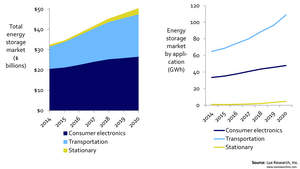BOSTON, MA--(Marketwired - Jul 15, 2014) - Energy storage, driven largely by electronics and plug-in vehicles, will grow at a compound annual growth rate of 8% to $50 billion in 2020, with dramatic shifts coming from the transportation industry, according to Lux Research.
Transportation applications will outpace electronics growth -- attaining an 11% CAGR to become a $21 billion market by the end of the decade. Its faster growth will close the gap with electronics, which still will remain the single largest market valued at $27 billion. The market for stationary applications will be worth $2.8 billion, as it awaits cost breakthroughs.
Additionally, incremental evolutions like start-stop technology are leading to significant changes in the energy storage market. With global sales of 59 million, a 53% market share and $6.1 billion in annual revenue, micro-hybrids will, for the first time, overtake the conventional internal combustion engine and emerge the most popular drivetrain by 2020.
"The automotive market is well on its way to displacing consumer electronics as the biggest user of energy storage. As that happens, it will lead to further scale and a new round of cost reductions, which will impact stationary applications as well," said Cosmin Laslau, Lux Research Analyst and the lead author of the report titled, "Finding Growth Opportunities in the $50 Billion Energy Storage Market."
Lux Research analysts evaluated opportunities as the energy storage market exhibits tremendous growth and significant shifts. Among their findings:
- Electric vehicles are the largest opportunity in transportation. With modest sales of 440,000 units, electric vehicles still will use $6.3 billion worth of energy storage -- more than the micro-hybrids, which will have sales two orders of magnitude higher at 59 million units. The United States will lead EV sales for most of the decade, peaking at 167,000 units in 2019 before expiring subsidies dampen sales. That will help China nearly catch up with the U.S. in 2020 -- attaining sales of 145,000, versus 148,000 in the U.S.
- Smartphones are the leader in electronics. The ever-growing popularity of smartphones, allied with a gradual increase in their battery capacity, will see this market segment growing at a 12% CAGR to $8.4 billion in 2020. Tablet computers follow with a 6% CAGR to $12 billion, the single largest energy storage consumption by a single application. In contrast, the energy storage market for feature phones, laptops and e-readers will shrink while wearables will not live up to the hype.
- Residential leads stationary applications. Driven by solar integration, residential represents the biggest opportunity in stationary energy storage applications -- leaping from less than $0.1 billion to $1.2 billion in 2020. A robust downstream industry, innovative financing and strong policies in countries such as Germany and the U.S. are favorable factors. UPS and backup applications provide the next largest opportunity, with $0.7 billion in 2020 revenues, while renewables shifting at the utility level with $0.3 billion, rounds out the top three.
The report, titled "Finding Growth Opportunities in the $50 Billion Energy Storage Market," is part of the Lux Research Energy Storage Intelligence service.
About Lux Research
Lux Research provides strategic advice and ongoing intelligence for emerging technologies. Leaders in business, finance and government rely on us to help them make informed strategic decisions. Through our unique research approach focused on primary research and our extensive global network, we deliver insight, connections and competitive advantage to our clients. Visit www.luxresearchinc.com for more information.
Contact Information:
Contact:
Carole Jacques
Lux Research, Inc.
617-502-5314
carole.jacques@luxresearchinc.com
